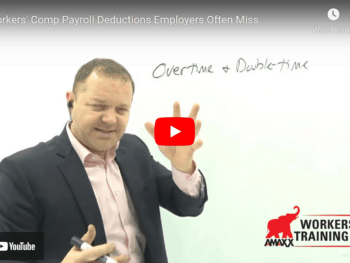Greater Reward & Higher Punishment for Amount of Claims
The National Council on Compensation Insurance (NCCI) is revising the way workers’ compensation insurance premiums are calculated. The revisions will reward the employers with below average claims with lower rates while increasing the rates for employers who have a higher than an average number of claims.
Change Will Impact Significant Majority of Country’s Employers
Starting January 1, 2013, the method used by NCCI to calculate the workers’ compensation premium for both new policy purchases and policy renewals will be altered. The change will impact a significant majority of the country’s employers as the NCCI premium calculation method is used in 38 states to set workers’ compensation premium rate. Every state Department of Insurance has approved the rating change. [WCx]
Independent rating bureaus in Indiana, Massachusetts, Michigan, Minnesota, New York, North Carolina, Texas and Wisconsin are reviewing their premium calculation method and may, or are, also changing their premium calculations methods following the NCCI lead. Employers in California, Delaware, New Jersey and Pennsylvania will probably not be impacted as the independent rating bureaus in those 4 states used premium calculation methods significantly different from NCCI.
Three Factors Go Into Workers Comp Premium
There are three factors that go into the calculation of an employer’s workers’ compensation premium. They are:
- The rate assigned to each payroll classification in the business
- The total amount of payroll for each classification code
- The experience modification factor.
Your insurance premium is calculated as:
Payroll classification X $100 of payroll
X experience modification factor = premium
The experience modification factor is the only factor that the employer can control without reducing the number of employees. It is also the part of the calculations where NCCI is reconfiguring how workers’ compensation premiums are calculated.
Current System Has Been in Place for 20 Years
The current system of calculating the experience modification factor has been in use for about 20 years. To calculate the experience modification factor, every loss is split into two parts, a primary portion and an excess portion, with both the primary losses and excess losses being used to calculate the experience modification factor. The split point is currently $5,000. The first $5,000 is referred to as the primary loss. The amount over $5,000 is the excess loss. Every loss has a primary loss, but only losses over $5,000 have an excess loss.
Both the primary loss and the excess loss are used to calculate the experience modification factor, with the primary loss carrying a heavier weight in the premium calculations. The primary losses are a direct reflection of the frequency of claims. The excess loss measures the severity of claims. Therefore, the greater the number of claims the employer incurs, the higher the workers’ compensation premium.
Split Point of Primary and Excess Losses Increased from $5,000 to $10,000
Effective January 1, 2013, the split point is being raised to $10,000 in the calculation of the number of primary losses and excess losses. This will result in a reduction in the number of excess losses. The work comp claims between $5,000 and $10,000 will no longer have an excess loss. The split point will change again on January 1, 2014 to $13,500 and will be revised again on January 1, 2015 to $15,000. Each of these changes will increase the weight of primary losses in the calculation of the experience modification factor. [WCx]
Recommendations to Minimize Potential Workers Comp Rate Increases
The following are recommendations for employers who want to minimize the potential workers’ compensation rate increases;
- Tighten up the work place safety program to lower the frequency of claims. This will have the greatest positive impact.
- Invest in loss control to identify potential sources of injury and eliminate those sources.
- Improve and enforce the return-to-work program to reduce the number of claims that have an excess loss portion.
- Focus on improving your medical management of claims to reduce the number of claims that have an excess loss portion.
The upcoming changes in the calculation of the experience modification factor will penalize the employers who have a greater than average number of claims for their payroll classification code while rewarding those employers who have a better than average loss history. For assistance on reducing your workers’ compensation cost, please contact us.
Author Rebecca Shafer, JD, President of Amaxx Risk Solutions, Inc. is a national expert in the field of workers compensation. She is a writer, speaker, and publisher. Her expertise is working with employers to reduce workers compensation costs, and her clients include airlines, healthcare, printing/publishing, pharmaceuticals, retail, hospitality, and manufacturing. She is the author of the #1 selling book on cost containment, Workers Compensation Management Program: Reduce Costs 20% to 50%. Contact: RShafer@ReduceYourWorkersComp.com.
Editor Michael B. Stack, CPA, Director of Operations, Amaxx Risk Solutions, Inc. is an expert in employer communication systems and part of the Amaxx team helping companies reduce their workers compensation costs by 20% to 50%. He is a writer, speaker, and website publisher. www.reduceyourworkerscomp.com. Contact: mstack@reduceyourworkerscomp.com.
WORKERS COMP MANAGEMENT MANUAL: www.WCManual.com
Do not use this information without independent verification. All state laws vary. You should consult with your insurance broker or agent about workers comp issues.
©2012 Amaxx Risk Solutions, Inc. All rights reserved under International Copyright Law. If you would like permission to reprint this material, contact us at: Info@ReduceYourWorkersComp.com.













